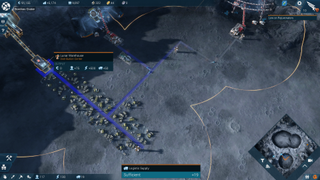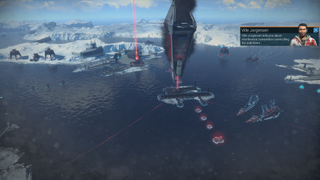Building To The Moon In 'Anno 2205'

The future is bleak. Global warming reduced once large and spacious chunks of land to small islands, and humanity continues its conquest for more energy in order to survive. This is the world of Anno 2205.
However, it doesn't look as bleak as one might think, as you are tasked to build cities in an effort to reach the Moon and gather its precious Helium-3 resources. The job is strenuous, mainly because of the balancing act of available resources and demand, but the payoff is rewarding, as you see these small patches of the Earth and Moon's surface slowly fill up with your sprawling cities.
We Built This City
For those who are more accustomed to city-building games such as Cities: Skylines, Anno 2205 is a milder version of the experience. You don't have to worry about the flow of traffic or zoning various areas for specific buildings. Instead, the main goal for your corporation is to have every settlement sustain a growing population and keep up production of various materials.
City management is just the tip of the iceberg in this expansive game. Multiple cities in different biomes need to be built to produce the building materials for various spaceports in your territories. This allows the transport of shuttles to the Moon, where you'll eventually set up a base to transport the rare Helium-3 materials.
Aside from the lunar surface, Earth provides two types of biomes for settlement: a temperate area and the more difficult tundra locations (more on that later). The game kicks off in an area of Earth with a temperate climate, allowing you to set up an effective first base of operations. You'll need a combination of enough workers, factories, energy producers, and food and water resources to grow the city. Not only do you need to keep the local populace working, but you also need to build more homes to attract newcomers.

Over time, you'll need access to better products, so citizens have to be promoted to a higher status. This unlocks another tier of new buildings for production and energy. A total of three tiers are available for each city, and the buildings in each tier require a chain of hierarchy to function properly. For example, the production of luxury foods requires a cattle farm and vineyard to supply its products. Without it, the building is just taking up space. The opening of each tier means that the demands of citizens for new products will rise, making management a little more challenging.
Speaking of which, another big challenge comes, as Anno players know all too well, when you start running out of space. The growing demand of factories coupled with bringing more people to work them can quickly snowball into a lack of real estate for other vital buildings. But this time around, Anno 2205 features modules for most buildings. These take up less space than another copy of a factory, and they help in various ways such as an increase in production, a decrease in the required workforce, or another decrease in the amount of energy to power it.
Stay on the Cutting Edge
Join the experts who read Tom's Hardware for the inside track on enthusiast PC tech news — and have for over 25 years. We'll send breaking news and in-depth reviews of CPUs, GPUs, AI, maker hardware and more straight to your inbox.
The idea of a module-based system isn't new (it was used in the disaster that was the new Sim City), but for a game that forces you to create your version of a tropical Manhattan, it's a welcome add-on. You can simply add smaller pieces to a large base instead of paying more credits to build an entirely new building to counteract deficits. It saves space and money. What's not to love about it?
There's also a Move tool, which helps with quickly putting buildings in their right place without having to suffer the consequences of a drastic drop in resources, even though it's only momentary. It also makes gameplay a little more forgiving. If you find yourself plopping an important building in a corner, the Move tool can place it an area where it can expand while moving less important structures into the old area to save space.
Moving On Up
Sooner or later, your temperate island won't have the exact building blocks to upgrade your spaceport, so you must build in the Arctic. The climate is a nightmare in the snowy region, and unlike the tropics, there's a limit to where you can build, based on the amount of heat output from each factory.
Whenever a new factory is built in the cold landscape, a small, circular border appears around it. This shows the area where houses can be built and stay warm due to the factory. Of course, combining multiple factories placed in strategic locations throughout the area increases the boundaries where you can safely place houses. The same idea applies to the Moon's surface, as well. Shield generators are required, as meteors rain down all over the surface. Every building has to be placed in these shield bubbles lest they get destroyed by a bunch of burning rock shooting down from the sky.

Both scenarios present a major challenge of expansion. The temperate climate allowed players to build anywhere if they had the money and resources to do so, but the threat of near-death temperatures and raining meteors slow down progression in a good way. Instead of making multiple rows of housing for your workforce, these boundaries help plan how you'll build a thriving city in these harsh environments.
That is to say that none of your cities work alone. Each one requires a little help from each other in the form of trade routes. Some settlements require specific resources found only in other places, or they need the materials to improve their spaceport. A global map shows the location of the cities, and you can easily pop-in between them at any time after a quick loading session. The loading is supposed to be close to a seamless experience, but multiple stuttering issues and the loading times ruin the experience.
War And Peace
Combat is back, but once again it's not as in-depth as some players will expect. These are smaller naval missions to take out an opposing force, accept small requests from other factions and gather rare materials. You take control of a series of ships and use various tools to keep them alive as well as inflict extra damage on the enemy. Compared to city-building, fighting in the seas is very simple, as it's all a matter of right-clicking to attack an enemy.
On the other end of the spectrum is diplomacy. From the very beginning, other companies are trying their hand at the Moon's resources. You can work with them to improve conditions on Earth for both parties or take part in a voting process that results in certain effects for all groups. Other characters linger in your area, offering the chance to buy resources as a quick way to get ahead, but I rarely used them, as it seemed more sound to keep the business in-house instead of having to rely on outside help. Then again, a few requests for collaboration, such as the reconstruction of a broken dam in the area, can yield large benefits in the form of currency or more energy power for your city.
Keeping The Balance
The fact that your cities work together makes Anno 2205 very different than its predecessors. What you do in one city can easily have a domino effect in another. For example, an increase in the number of residents causes the demand for more food to go up. However, that will affect imported and exported goods as well because of the power consumed by the new food facilities, which means you have to build more modules in your power plant. The vitamin drinks you export will also suffer because of the double demand both at home and other cities, forcing you to build more factories, which might require some imported materials from another city, which has to build more shops to keep up with the demand (See what I mean?).

It's all very intimidating, especially when every move can really change the mood of citizens and their demands, but returning your growing corporate empire in a balanced state is easy, mainly due to the new modules and Move tool. It's almost like the game allows you to make mistakes in the early planning stages and then correct them how you see fit as the city expands.
It's this meticulous attention to maintaining that balance that makes the game surprisingly fun. Various tooltips are available for every building so that you know how to effectively manage each cog in your city. For newcomers, such as myself, there is no proper tutorial, unless you count the various tutorial-based objectives that continue to pop up every few minutes or so. It doesn't take long to get used to gameplay, so the tutorial tips quickly become useless.
There's no denying that Anno 2205 is quite an enjoyable game. It's easy to understand, easy to build, and even the smallest problems such as a lack of resources or a negative balance are easy to rectify in a few minutes. Still, the road to the Moon is filled with difficulties, testing your patience and strategy as you shoot for it. It's a long and challenging process just to prepare for spaceflight, but each second leading up to it is filled with excitement and strategic planning in the future world of 2205.
______________________________________________________________________

Rexly Peñaflorida II is a Contributor at Tom’s Hardware. He writes news on tech and hardware, but mostly focuses on gaming news. As a Chicagoan, he believes that deep dish pizza is real pizza and ketchup should never be on hot dogs. Ever. Also, Portillo’s is amazing.
Follow Rexly Peñaflorida II @Heirdeux. Follow us on Facebook, Google+, RSS, Twitter and YouTube.
-
hoofhearted You should mention the UPlay DRM! This makes it a no-purchase decision for me! The UPlay client has to be the most horrible thing created (locks out after 5 installs, password resets take forever, etc) I wish Steam would not allow such foolishness. And why should I have to maintain another set of credentials in addition to Steam?Reply
Most Popular

